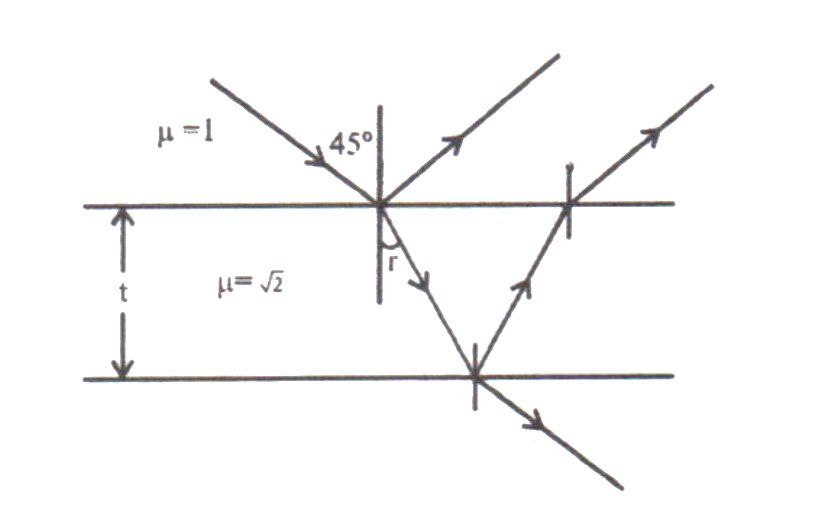An oil film covers the surface of a small pond. The refractive index of the oil is greater than that of water. At one point on the film, the film has the smallest non-zero thickness for which there will be destructive interference in the reflected light when infrared radiation with wavelength 800 nm is incident normal to the film. When this film is viewed at normal incidence at this same point, for what visible wavelengths, if any, will there be constructive interference? (Visible light has wavelengths between 400nm and 700 nm )
To solve the problem, we need to determine the conditions for destructive and constructive interference for the oil film on the pond. Here’s a step-by-step solution:
Step 1: Understanding Destructive Interference
For destructive interference in a thin film, the condition is given by:
2μt=(n+12)λ
where:
- μ is the refractive index of the oil,
- t is the thickness of the oil film,
- n is an integer (0, 1, 2,...),
- λ is the wavelength of the incident light.
For the smallest non-zero thickness that results in destructive interference, we can set n=0:
2μt=12λ
This simplifies to:
μt=λ4
Step 2: Calculating the Thickness for Infrared Light
Given that the wavelength of the infrared radiation is λ=800nm:
μt=800nm4=200nm
Step 3: Condition for Constructive Interference
For constructive interference, the condition is:
2μt=nλ
where n is an integer (1, 2, 3,...).
Step 4: Finding Wavelengths for Constructive Interference
Substituting μt=200nm into the equation for constructive interference:
2×200nm=nλ
This gives:
400nm=nλ
Thus, we can express the wavelength as:
λ=400nmn
Step 5: Finding Visible Wavelengths
We need to find values of n such that λ falls within the visible range (400 nm to 700 nm):
1. For n=1:
λ=400nm1=400nm
2. For n=2:
λ=400nm2=200nm (not visible)
3. For n=3:
λ=400nm3≈133.33nm (not visible)
Since n=1 gives a wavelength of 400 nm, which is at the edge of the visible spectrum, and all other values of n yield wavelengths outside the visible range, the only visible wavelength that results in constructive interference is:
λ=400nm
Final Answer
The visible wavelength for which there will be constructive interference is 400 nm.
---
For destructive interference in a thin film, the condition is given by:
2μt=(n+12)λ
where:
- μ is the refractive index of the oil,
- t is the thickness of the oil film,
- n is an integer (0, 1, 2,...),
- λ is the wavelength of the incident light.
2μt=12λ
This simplifies to:
μt=λ4
Given that the wavelength of the infrared radiation is λ=800nm:
μt=800nm4=200nm
For constructive interference, the condition is:
2μt=nλ
where n is an integer (1, 2, 3,...).
Substituting μt=200nm into the equation for constructive interference:
2×200nm=nλ
This gives:
400nm=nλ
Thus, we can express the wavelength as:
λ=400nmn
We need to find values of n such that λ falls within the visible range (400 nm to 700 nm):
1. For n=1:
λ=400nm1=400nm
2. For n=2:
λ=400nm2=200nm (not visible)
3. For n=3:
λ=400nm3≈133.33nm (not visible)
λ=400nm
The visible wavelength for which there will be constructive interference is 400 nm.
Topper's Solved these Questions
- INTERFERENCE AND DIFFRACTION OF LIGHTBOOK - DC PANDEY ENGLISHCHAPTER - INTERFERENCE AND DIFFRACTION OF LIGHTEXERCISE - Subjective Questions
5 Videos
- INTERFERENCE AND DIFFRACTION OF LIGHTBOOK - DC PANDEY ENGLISHCHAPTER - INTERFERENCE AND DIFFRACTION OF LIGHTEXERCISE - Level 2 Single Correct
11 Videos
- INTERFERENCE AND DIFFRACTION OF LIGHTBOOK - DC PANDEY ENGLISHCHAPTER - INTERFERENCE AND DIFFRACTION OF LIGHTEXERCISE - Objective question
2 Videos
- GRAVITATIONBOOK - DC PANDEY ENGLISHCHAPTER - GRAVITATIONEXERCISE - All Questions
135 Videos
- MAGNETIC FIELD AND FORCESBOOK - DC PANDEY ENGLISHCHAPTER - MAGNETIC FIELD AND FORCESEXERCISE - Medical entrance s gallery
59 Videos
Similar Questions
Refractive index of a thin soap film of a uniform thickness is 1.34. Find the smallest thickness of the film that gives in interference maximum in the reflected light when light of wavelength 5360Å fall at normal incidence.
View SolutionRefractive index of a thin soap film of a uniform thickness is 1.38. The smallest thickness of the film that gives an interference maxima in the reflected light when light of wavelength 5520 Å falls at normal incidence is
View Solution
Knowledge Check
What is the minimum thickness of a soap bubble needed for constructive interference in reflected light, if the light incident on the film is 750 nm? Assume that the refractive index for the film is n=1.33
A282 nmB70.5 nmC141 nmD387 nmThe colours seen in the reflected white light from a thin oil film are due to
ADiffractionBInterferenceCPolarisationDDispersion
What is the minimum thickness of thin film required for constructive interference in the reflected light through it ?
(Given, the refractive index of the film =1.5, wavelength of the lilght incident on the film =600 nm.
View SolutionWhat is the minimum thickness of a thin film (μ=1.2) that results in constructive interference in the reflected light? If the film is illuminated with light whose wavelength in free space is λ=500nm ?
View SolutionWhat is the minimum thickness of a soap bubble needed for constructive interference in reflected light, if the light incident on the film is 750 nm? Assume that the refractive index for the film is n=1.33
View SolutionCalculate the minimum thickness of a soap bubble film (μ=1.33)that results in constructive interference in the reflected light if the film is illuminated with light whose wavelength in free space is λ=600nm.
View SolutionA ray of light is incident at an angle of 45∘ (ralative to the normal) on a thin film of a liquid with an index of refraction of √2. Assuming that the medium of both sides of the film is air, find the minimum thickness of the film required for constructive interference in the reflected light for sodium light of wavelenght 600 nm.

View SolutionApproximate thickness of oil film to observe interference of light (due to which it looks coloured) is
View Solution
